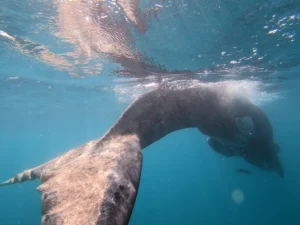The pineapple fish (Cleidopus gloriamaris), also known as the Mailfish or Knightfish, is an intriguing species belonging to the Monocentridae family. Inhabiting the Pacific and Indian Oceans, from South Africa to Australia and Japan, this elusive species thrives at varying depths, typically ranging from 6 to 200 metres, and favouring habitats such as coral reefs and sheltered overhangs. Sporting small, nondescript fins, the pineapple fish is not known for its swimming agility. As a primarily nocturnal species, these fish often take refuge inside caves and under rocky ledges during the day. At night, they venture onto sandy flats to feed, utilising their bioluminescent light to illuminate small crustaceans and other benthic invertebrates. While a rare sight in Cape Town’s kelp forests, pineapple fish are sometimes found in shallow rocky reef areas.
As its name suggests, the pineapple fish has a unique and distinctive appearance. It grows up to approximately 22 centimetres in length, featuring a round body covered in spiny, armour-like scales. The coloration of their scales is a striking yellow to white with black margins, creating the captivating pattern that gives this species its name. A red stripe on the lower jaw leads to the photophore, which emits a bioluminescent glow.

The pineapple fish is renowned for its bioluminescence, as it plays an important role in survival, aiding in both camouflage and communication. The bioluminescent organs allow them to blend in with the faint blue light filtering down from the ocean’s surface, thus avoiding detection by predators and prey. Furthermore, it also serves as a means of communication at depths where light is minimal. The pineapple fish’s glow is facilitated by a symbiotic relationship with a bioluminescent bacteria called Aliivibrio fischeri, which inhabit the fish’s light organs. This partnership is mutualistic, as it benefits both the pineapple fish by providing luminescence, and the bacteria, which find a protective environment within the fish’s photophores.

Despite their protective adaptations such as armour-like scales and sharp spines, pineapple fish still fall prey to larger deep-sea predators. To deter prospective threats, they have the ability to erect their dorsal spines, which, along with their bioluminescent display, serves as a warning to potential attackers.
While moderately common in deep waters, they are not frequently encountered due to their reclusive nature, and the species was initially only known from specimens that washed ashore during storms. Although not a targeted species for fisheries, pineapple fish often become bycatch for commercial trawlers, and due to their distinctive appearance and intriguing behaviours, they have gained popularity among saltwater fish aquarists. Their hardiness and unique bioluminescence make them prized additions to public and private aquariums.
The pineapple fish was assessed by the IUCN Red List of Threatened Species in 2019, to determine its conservation status. The assessment revealed no known major threats, and the species was therefore classified as Least Concern, with an unknown population trend. This curious species remains elusive, and much further research is required in order to gain a better understanding of the pineapple fish and its ecological interactions with the marine environment.



